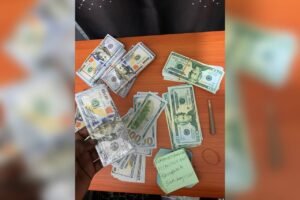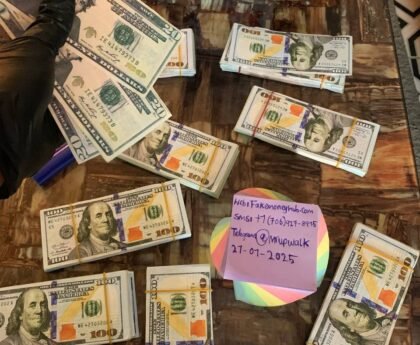Buying Counterfeit Money Dollars | Fake Bills
Protecting yourself from Counterfeit Banknotes is crucial to avoid financial loss and legal issues. Counterfeit money refers to fake or fraudulent currency produced with the intent to deceive people into accepting it as genuine. Here are some detailed steps on how to protect yourself from Counterfeit Money:

1. Know the Features of Real Currency
Different countries have specific security features on their banknotes to distinguish them from counterfeit currency. Knowing these features is the first line of defense.
Common security features on banknotes:
- Watermarks: Many currencies have watermarks that can be seen when the bill is held up to light.
- Security Thread: A thin strip embedded in the paper that runs vertically through the note. It may have text, patterns, or change color.
- Holograms: Some currencies use holograms that change images or colors when viewed from different angles.
- Microprinting: Tiny text that is difficult to replicate, often found in the borders or in fine details of the design.
- UV Ink: Under ultraviolet light, certain parts of the note may glow, revealing hidden security features.
- Raised Print: Certain areas of the note, like the denomination or portrait, may feel slightly raised when touched.
- Color-Shifting Ink: Some banknotes include ink that changes color when tilted.
- Special Paper: Genuine notes are often printed on unique paper that may feel different from regular paper and can include embedded fibers or security threads.
2. Use Detection Tools
There are various tools you can use to help detect Counterfeit Banknotes:
– UV Light Detectors:
These lights reveal invisible features, such as UV ink or patterns that are embedded into the note and are not visible under normal lighting.
– Magnifying Glass:
Use a magnifying glass to closely inspect the microprinting and fine details on the banknote. Counterfeit bills often have blurry or imperfect details in these areas.
– Currency Detectors:
There are handheld devices that use various methods (ultraviolet light, magnetic ink detection, etc.) to identify Counterfeit Currency.
3. Examine the Bill Carefully
When you receive a bill, take a few seconds to check for the following:
- Feel: The texture of a real note is different from paper or common materials. Real currency is typically printed on a special cotton or polymer-based paper that feels distinct.
- Look: Compare the bill closely with a known genuine note. Check for color shifts, intricate patterns, and holographic features.
- Tilt: Hold the bill at different angles and see if any holographic elements, color shifts, or watermarks become visible.
- Check Serial Numbers: Counterfeit bills may have inconsistent or duplicate serial numbers. Ensure that the serial numbers are unique and match the format of the currency.
4. Know How Counterfeit Money Enters Circulation
Counterfeit money can be distributed in a variety of ways. Some of the common methods are:
- Street Vendors or Unfamiliar Places: Often, counterfeit bills are passed to unsuspecting people at markets, shops, or places where transactions are rushed or informal.
- Online Purchases: Counterfeit Banknotes can sometimes be hidden in packages from online sellers, especially when buying from untrustworthy or unknown sources.
- ATMs and Banks: While rare, some Counterfeit Bills may be dispensed through ATMs if the machine doesn’t have proper counterfeit detection mechanisms. It’s important to check all cash dispensed by ATMs and banks.
Counterfeit Banknotes | Buy Fake Banknotes Online
5. What to Do If You Receive Counterfeit Money
If you receive counterfeit money, it is important to act quickly and appropriately:
– Do Not Attempt to Pass It Off: Trying to use counterfeit money, knowingly or unknowingly, is illegal and could lead to criminal charges.
– Notify Authorities: If you realize you’ve received a counterfeit note, contact the local police or your country’s national central bank. Many countries have special units that handle counterfeit currency cases.
– Hold Onto the Bill: If possible, avoid letting the counterfeit bill out of your possession. You may need to provide it as evidence, and authorities will likely want to inspect it.
– Fill Out a Report: In some cases, if you unknowingly accepted a counterfeit bill, you’ll need to fill out a report or form with local authorities or your bank. They may be able to assist you in replacing the counterfeit note, depending on the circumstances.
6. Educate Employees or Others in Your Business
If you’re a business owner or in charge of a store or office where cash is exchanged frequently, ensure that your staff is trained in identifying Counterfeit Banknotes. Some key training points include:
- Familiarizing employees with the security features of real currency.
- Using detection tools and techniques regularly during transactions.
- Setting up a policy for handling counterfeit money if it is received, including notifying managers or law enforcement.
7. Invest in High-Quality Detection Equipment
For businesses or individuals who handle large volumes of cash, investing in counterfeit detection machines can save time and reduce the risk of accepting fake currency. These machines typically detect Counterfeit Banknotes based on a variety of features, including:
- Ultraviolet (UV) light
- Magnetic ink
- Size and dimensions
- Infrared scanning
8. Know the Law
It’s important to understand the laws surrounding counterfeit currency in your country. In most places, knowingly passing counterfeit money is a criminal offense and can result in significant fines or imprisonment. Even if you unknowingly accept counterfeit money, it’s important to report it promptly to avoid potential legal complications.
9. Keep Up-to-Date with New Security Features
Banknotes and security features are regularly updated to stay ahead of counterfeiters. Keep yourself informed about any new changes to the currency in circulation, including the release of new bills or updates to security features. National central banks or mints often publish information about changes to currency.
10. Use Electronic Transactions When Possible
While cash remains a common payment method, digital transactions via credit cards, mobile payments, and bank transfers are much less likely to involve counterfeit money. Reducing the amount of cash you handle and encouraging others to use digital payments can help avoid this risk.
By following these tips and staying vigilant, you can protect yourself from counterfeit currency and minimize your risk of accepting fake bills.





